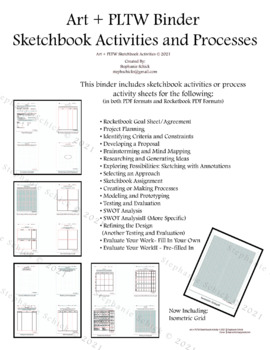PLTW, Science and Art Processes and Activities Binder
Winter Studios
2 Followers
Grade Levels
6th - 12th, Higher Education, Adult Education, Homeschool
Resource Type
Standards
CCSS8.SP.A.1
CCSS8.SP.A.2
CCSS8.SP.A.3
CCSS8.SP.A.4
CCSS8.NS.A.1
Formats Included
- PDF
Pages
39 pages
Winter Studios
2 Followers
Description
Art + PLTW + Science Binder
Sketchbook Activities and Processes
This binder includes (in both PDF formats and Rocketbook PDF Formats) sketchbook activities or process activity sheets for the following:
• Rocketbook Goal Sheet/Agreement
• Project Planning
• Identifying Criteria and Constraints
• Developing a Proposal
• Brainstorming and Mind Mapping
• Researching and Generating Ideas
• Exploring Possibilities: Sketching with Annotations
• Selecting an Approach
• Sketchbook Assignment
• Creating or Making Processes
• Modeling and Prototyping
• Testing and Evaluation
• SWOT Analysis
• SWOT AnalysisII (More Specific)
• Refining the Design
(Another Testing and Evaluation)
• Evaluate Your Work- Fill In Your Own
• Evaluate Your WorkII - Pre-filled In
Total Pages
39 pages
Answer Key
N/A
Teaching Duration
3 Weeks
Report this resource to TPT
Reported resources will be reviewed by our team. Report this resource to let us know if this resource violates TPT’s content guidelines.
Standards
to see state-specific standards (only available in the US).
CCSS8.SP.A.1
Construct and interpret scatter plots for bivariate measurement data to investigate patterns of association between two quantities. Describe patterns such as clustering, outliers, positive or negative association, linear association, and nonlinear association.
CCSS8.SP.A.2
Know that straight lines are widely used to model relationships between two quantitative variables. For scatter plots that suggest a linear association, informally fit a straight line, and informally assess the model fit by judging the closeness of the data points to the line.
CCSS8.SP.A.3
Use the equation of a linear model to solve problems in the context of bivariate measurement data, interpreting the slope and intercept. For example, in a linear model for a biology experiment, interpret a slope of 1.5 cm/hr as meaning that an additional hour of sunlight each day is associated with an additional 1.5 cm in mature plant height.
CCSS8.SP.A.4
Understand that patterns of association can also be seen in bivariate categorical data by displaying frequencies and relative frequencies in a two-way table. Construct and interpret a two-way table summarizing data on two categorical variables collected from the same subjects. Use relative frequencies calculated for rows or columns to describe possible association between the two variables. For example, collect data from students in your class on whether or not they have a curfew on school nights and whether or not they have assigned chores at home. Is there evidence that those who have a curfew also tend to have chores?
CCSS8.NS.A.1
Know that numbers that are not rational are called irrational. Understand informally that every number has a decimal expansion; for rational numbers show that the decimal expansion repeats eventually, and convert a decimal expansion which repeats eventually into a rational number.


